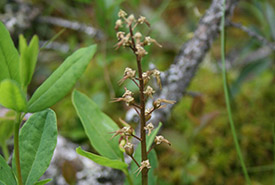Rare orchid found near Quebec City spurs protection efforts
Nature Conservancy of Canada buys bog to protect water, rare orchid
Southern twayblade, QC (Photo by NCC)
Forty-two kilometres from Quebec City, in the heart of a peat bog located at the junction of three municipalities; Fossambault-sur-le-Lac, Shannon and Sainte-Catherine-de-la-Jacques-Cartier, something marvelous was discovered by a biologist with the Nature Conservancy of Canada (NCC): a threatened species of orchid. One year after the find, a 112-hectare property, the equivalent of 708 NHL-sized skating rinks, was purchased by NCC. This wetland, acquired with financial support from the Ministère des Forêts, de la Faune et des Parcs, is very important for the health of nature in this area, in addition to providing habitat for many animals and plants.
The land near Fossambault-sur-le-Lac offers not just critical habitat for the rare southern twayblade orchid, it also filters water that flows north into Lac Saint-Joseph. To keep a lake healthy, it is important to protect its shores, as well as the streams, marshes or bogs that are connected to it. Bogs are wetlands that support sensitive species that might not thrive elsewhere. These spaces also provide a range of environmental benefits, such as absorbing excess water and helping to limit the impacts of climate change by absorbing carbon.
NCC’s initial survey of the bog in 2020 found animal tracks and suitable environments for a range of animals, among them Canada warbler (threatened), olive-sided flycatcher (threatened), as well as pickerel frog, four-toed salamander and smooth green snake, all of which are likely to be designated as threatened or vulnerable.
Nevertheless, the star of this wetland remains southern twayblade, which is designated as threatened in Quebec. This beautiful, delicate and rare little orchid is found only in certain bogs in southern Quebec. Its red flowers are arranged in clusters on its stem and its small size (10 to 21 centimetres in height) make it a very different orchid from the ones we know as houseplants. It also shares its environment with a few curiosities of the plant kingdom: insectivorous plants, such as pitcher plant and spatulate leaf sundew.
Acknowledgements
NCC would like to thank its financial partners who contributed to the protection of this site, including the Ministère des Forêts, de la Faune et des Parcs du Québec, the U.S. Fish and Wildlife Service under the North American Wetlands Conservation Act, Martin Bédard of Bleu, Gestion & Investissements inc. and Bilodard inc.
About
The Nature Conservancy of Canada (NCC) is Canada’s leading not-for-profit private land conservation organization, working to protect our most important natural areas and the species they sustain. Since 1962, NCC has helped to protect more than 15 million hectares, coast to coast to coast, including around 118,600 acres (48,000 hectares) in Quebec. To learn more, visit natureconservancy.ca.
The Ministère des Forêts, de la Faune et des Parcs is responsible for the sustainable management of forests and wildlife for the benefit of the citizens of Québec. Through its wildlife mission, the Ministry aims to ensure the maintenance of biodiversity and the conservation of species and their habitats while promoting their development. As part of its mission, it collaborates with several partners in the field, which includes a long-standing partnership with the Nature Conservancy of Canada.
The North American Wetlands Conservation Act (NAWCA) is a program administered by the U.S. Fish and Wildlife Service.






